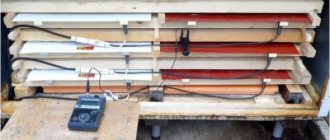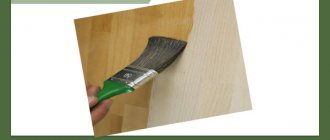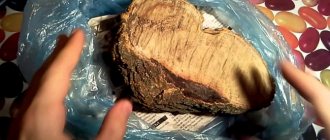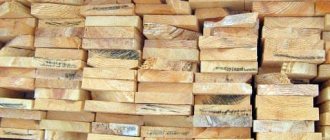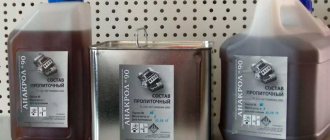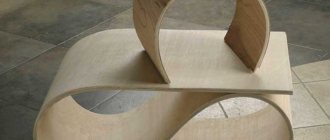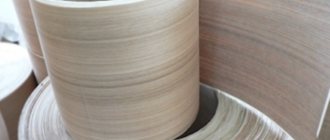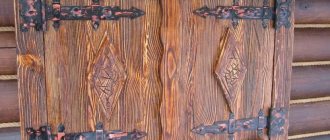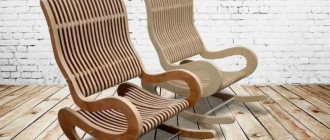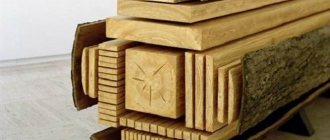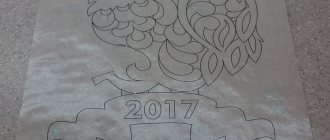Among wood processing technologies, one of the most interesting and exciting aspects is giving the workpiece strength and resistance to negative environmental influences. Traditionally, several treatment options are used at home - applying a protective layer and impregnation with conservation formulations. But as practice shows, such methods do not give much effect; after 2-3 years you have to correct coating defects and re-do the treatment. This state of affairs often prompts the search for new solutions to the problem of protecting wood products, for example, such a method as stabilizing wood at home.
What is wood stabilization?
This process is a kind of conservation. Internal processes in the structure of wood stop. The product remains forever the same as at the time of stabilization.
Due to the high cost of consumables, high time costs and complexity, this procedure is practically not used on an industrial scale, but is excellent for processing small products:
- furniture;
- crafts;
- toys;
- interior/exterior items;
- knife handles.
Stabilized wood: completion of processing, polymerization
The workpiece is polymerized by drying. Some types of compositions can be self-hardening, others must be subjected to intense drying at high temperatures. Polymerized wood gains additional weight, new color and properties.
The result of correct execution of this stage is stabilized wood. With their own hands (a photo of the finished sample is posted in the article), wood is processed, as a rule, by those craftsmen who subsequently plan to sell the resulting material.
Often these craftsmen are also engaged in the manufacture of exclusive wooden products, which are excellent as gifts and souvenirs. Stabilized wood is most often used for knives (handles), lighter bodies and pens, jewelry boxes, as well as various jewelry (beads, bracelets, medallions).
Main goals of stabilization
The primary task is to protect the wood from the negative effects of moisture. After impregnation, the fibers become impervious to all kinds of liquids and chemical treatments. They do not increase, do not lose their performance characteristics, and retain their shape and color.
This procedure is not just impregnation, but filling the entire available space between the fibers. For this purpose, protective compounds are used that clog pores.
Stabilization helps improve the consumer qualities of wood. The best effect can be achieved with compositions that have the ability to polymerize. Most often used for this purpose:
- natural resins;
- polymers;
- paints and varnishes;
- all kinds of oils.
Properties of the cured material
Proper impregnation at home helps to achieve the following results:
- Wood gains increased strength.
- The fiber density increases. There are fewer voids and cavities in the structure.
- Products become immune to external influences, sudden temperature changes, and increased relative humidity.
- The surface becomes resistant to ultraviolet radiation. It does not fade in direct sunlight, remaining amazingly beautiful.
- Crafts and furniture are insensitive to short-term exposure to flame. Strong heating does not lead to deformation.
- High density prevents oils and all kinds of solvents from penetrating deep into the structure.
Despite this, stabilized wood remains malleable to mechanical processing. It can be sawed, ground, cut, sanded, polished. This expands the possibilities for making decorative products.
Benefits of processed material
Stabilized wood does not require the application of any solutions, because it is thoroughly impregnated with special agents. Stabilization technology involves filling the pores and cavities of the raw material with a preservative substance, which, after hardening, turns the wood into a material with completely new properties:
- high density, hardness and strength;
- resistance to temperature changes and changes in humidity in the environment;
- complete immunity to ultraviolet rays;
- the ability to be in an open flame for a short time without loss of quality characteristics, changes in appearance and deformation;
- impermeable to any oil;
- resistance to organic solvents.
In addition to all of the above, stabilized wood is extremely beautiful. Transparent or colored impregnation emphasizes the natural pattern of wood fibers, sometimes creating incredible and magnificent patterns. The resulting material can be processed either manually or mechanically.
Benefits of the procedure
Unlike other wood processing methods, stabilization allows for a long-lasting effect. Varnishing, for example, creates a protective layer only on the surface. And filling the pores with compounds with polymerizing properties ensures complete treatment throughout the entire structure, strengthening it inside and out. As a result, wood acquires more effective protection from external factors.
There is another interesting factor. Stabilized wood is more reminiscent of natural stone in its structure. Its cut pattern is similar to marble. This is where the process of filling the pores with a specially selected product comes into play.
Stabilizing compounds for wood
You can achieve the desired result using various materials and compositions. Some are cheaper, others are more expensive. To easily decide on the ideal product, you should consider each option in detail.
Epoxy resin
Suitable for almost all types of wood, except coniferous. Before impregnation, it is necessary to ensure that the material has normal fluidity (the speed and density of filling the pores depends on this). You can achieve the desired result with an alcohol solution of resin, but its preparation is a labor-intensive procedure.
If the polymerization process occurs in a vacuum chamber, then there is a possibility of the epoxy resin boiling. This is its natural property along with low fluidity.
Liquid glass
It is actively used in everyday life because it is affordable and does not cause difficulties in use. After treating wood with liquid glass, a protective film is formed on its surface that is resistant to various dyes.
This composition is used to stabilize decorative products and structural elements that are not subject to additional treatment with protective compounds in the future. Liquid glass protects wood from mold and fungi. It is characterized by resistance to external influences, including UV radiation, high moisture, and high temperatures.
Brine
The cheapest, but least practical way to stabilize wood at home. The proportions look like this:
- 1 tablespoon of ordinary salt (regardless of grinding);
- 1 liter of water.
To stabilize, it is necessary to boil the wood product for 2-3 hours.
Drying oil
An ideal solution for stabilizing wooden crafts. Drying oil contains vegetable oils that have undergone heat treatment. This provides increased resistance to moisture as well as direct sunlight. To ensure that the viscosity of the drying oil is sufficient for processing wood, a solvent is added to it.
This composition provides protection against the influence of adverse factors:
- rotting;
- deformations;
- gradual wear.
If you need to stabilize furniture and decorative items, it is better to choose drying oil based on natural ingredients. Alkyd and composite compounds are suitable for treating external products.
Composition for vacuum chamber
This technology is good because it ensures complete impregnation of wood. The products penetrate deep into the structure of the fibers, saturating them and providing them with protective properties. At a pressure of 12 kg/sq. cm impregnation can penetrate to a depth of 0.3 to 5.0 cm. This depends on the type of wood, its age, density and a number of other factors.
For this purpose, a product called Anacrol-90 is used. It will be discussed later, but for now let’s highlight another composition for stabilizing wood.
Birch juice
Excellent for polymerization. Birch sap does not contain harmful components, toxins, or carcinogens, and therefore is safe to use. For deep penetration, it is recommended to use a vacuum chamber, and the result can be secured by drying at a temperature of +90 degrees Celsius.
To achieve a beautiful decorative effect, you can add natural dyes to birch sap. This will expand the possibilities for stabilization.
Polymers
Polymer compositions are excellent for processing wooden products because they have high penetrating ability, as well as natural polymerization, which occurs quite quickly. There are a large number of products on sale that are suitable for this procedure. We have collected the most effective ones.
"Anacrol-90"
This is a special composition intended exclusively for stabilizing wood in a vacuum chamber, which you can make yourself using:
- Vacuum pump;
- compressor;
- pressure gauge;
- tubes and taps;
- plastic containers.
"Anacrol-90" is a polyester impregnation that turns into a thermosetting polymer under the influence of high temperature. Thanks to this composition, the wood becomes insensitive to strong impacts and the effects of negative environmental factors. In addition, it becomes resistant to chemical reagents.
"100therm"
A product made on the basis of thermosetting polymers. It is a transparent liquid of medium viscosity. Excellent for wood processing. For ease of transportation and storage, it is supplied in tin cans. Suitable for industrial and home use.
"Buravid"
This product contains optical pigments that are responsible for the polymerization process of wood. “Buravid” has a slight viscosity, thanks to which it easily penetrates even into tiny pores.
This composition helps to avoid biological contamination of wood. In addition, “Buravid” emphasizes the natural pattern of the fibers, making it more expressive and beautiful.
"Pentacryl"
Made on an alkyd base. During production, fat-soluble pigments and dyes are added to this product, which makes it possible to saturate wooden products and give them a deep, expressive color. With the help of "Pentacryl", the polymerization process occurs outside and inside, while the composition does not contain harmful components, and therefore is safe for use at home.
Technological process of stabilization
This procedure requires careful preparation, and you also need to take into account the properties of the chosen product. Stabilization technology directly depends on the composition of the impregnation. For convenience, the most popular polymerization methods will be considered.
Step-by-step processing of wood with Anacrol
First, you will need a container into which the selected workpiece will completely fit. It must be filled with Anacrol-90 so that the wooden product sinks into it. After this, it is necessary to create vacuum conditions until air bubbles cease to be released and appear in the liquid.
Next, you should leave the workpiece in the impregnation for 20 minutes, and then create an excess pressure of about 2-4 atmospheres. At this stage you will need a compressor or a special pump.
After completing this procedure, you need to wait half an hour and then repeat it. If the workpiece sinks in water, it means there are no unfilled pores left in it. If it floats, it is recommended to repeat the treatment with Anacrol again. The final stage is drying, which can be carried out in an ordinary oven at a temperature of +90... +100 degrees Celsius. To achieve a special effect, you can add colored pigment to Anacrol-90.
Epoxy resin treatment
This process is similar to the one described above, but the difference in fluidity must be taken into account. Epoxy resin is very viscous in structure, so it must be diluted with alcohol. In addition, polymerization takes a long time, so you need to be patient.
When processing wood, it is recommended to ensure that the resin does not boil when creating a vacuum. Otherwise, the workpiece may be damaged, and the result will be unpredictable.
Oil impregnation
This procedure is much simpler, more convenient and more economical in terms of costs. Any oil can be used:
- sesame;
- nutty;
- linen;
- tung.
Cold impregnation is very convenient and practical, suitable for small workpieces. To do this, it is enough to completely soak the wood. The difficulty is that the polymerization process takes from 3 to 14 days, depending on the selected breed. All this time the workpiece must be kept immersed in oil.
Acceleration of polymerization
Sometimes the process of preserving wood takes a lot of time, but you can resort to one trick. First you need to thoroughly dry the wooden piece. This will remove excess moisture from it, and open pores will more easily accept the composition for subsequent polymerization.
Cleaning the composition
If the selected product contains any inclusions, additives or even small debris, this can harm polymerization and ruin the workpiece, which is unacceptable. Therefore, it is recommended to first filter the composition. For this purpose, ordinary gauze folded several times is suitable. This will retain impurities, and the output will be a clean product suitable for preserving wood.
Color change
By adding natural dyes, you can get an amazing effect. The process is suitable both for blackening wood and for creating unusual colored stains in its structure (not only on the surface). For this it is recommended to use concentrated pigments. An excellent choice would be Anacrol.
Stage 2
1/ Soak bars No. 3 and No. 4 in Anacrol for 1 hour (let them get used to it)).
2/ Then we immerse them in a vacuum chamber and pump out the air.
3/ Vacuum until the end of the boil (about 30 minutes).
4/ Let stand at normal pressure for 30 minutes.
5/ Repeat processes No. 2, 3 and 4 two or three times. If everything is done correctly, then when the bars are completely impregnated, they should completely sink in the impregnating composition.
That's all for today. Tomorrow we will weigh the bars again, determine how much of the composition they have absorbed, and also move on to
DIY painting mistakes
Many beginners make a lot of mistakes in the process of stabilizing wood. It would be a mistake to apply the composition with a brush. So its quantity will not be enough to penetrate deep into the fibers, and the treatment itself will turn out to be superficial and of poor quality. Over time, cracks may appear inside the product, which will lead to deformation.
When working with a vacuum chamber, you should adhere to the permissible pressure of 2–4 atm and not exceed it. It is not recommended to dry wood at temperatures above +100 degrees Celsius.
Under no circumstances should you rush. Be patient and prepare for the fact that stabilization will take more than a day. But this approach will help achieve an ideal result.
Methods
The technological process of wood stabilization is divided into two stages - impregnation and polymerization.
Depending on the type, size and quality of the raw material, as well as taking into account your own capabilities and preferences, you can stabilize wood in the following ways:
- Cold impregnation. The most affordable way to stabilize small workpieces, which involves soaking the wood in a cold composition. The duration of impregnation ranges from 3 days to 2 weeks depending on the type of raw material. Various oils are used as preservatives - nut, tung, hemp and linseed.
- Hot impregnation. A complex option for preserving bulk wood products. The duration of impregnation can be up to 2-3 days and ensures deeper penetration of hot compounds into wood fibers.
- Vacuum processing. This processing method involves the use of a vacuum chamber. Evacuation of air from the chamber is accompanied by removal of the existing liquid from the wooden blank placed inside. Next, a stabilizing solution is fed into the chamber, which is designed to fill the open pores of the wood.
- Processing under pressure. This method is similar to the previous one, the difference is that wood preservation is carried out using high pressure rather than vacuum. The wooden blank is placed in a container with liquid and installed in the chamber. Under the influence of high pressure, air is removed from the pores, and the voids are filled with a polymerizing composition.
